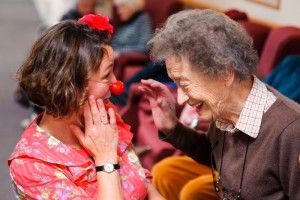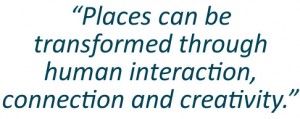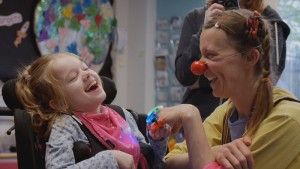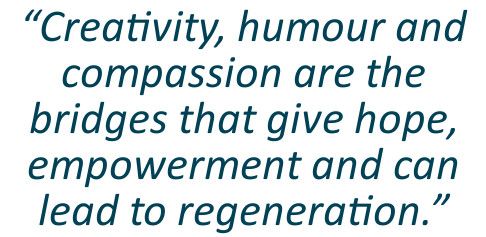For many people the word ‘regeneration’ provokes images around changes to the built environment and local economies, but SURF and others argue that it should also be thought of as a social concept. Here, Magdalena Schamberger of Hearts & Minds and the European Cultural Parliament discusses the charity’s Clowndoctors and Elderflowers initiatives and the value of creativity for building essential ‘bridges’ to connect with health service users.
I am in charge of a bunch of clowns. No joke – that’s a fact!

One of the Elderflowers, Blossom, interacts with a service user in Edinburgh’s Braeside House care home
I have the privilege of leading a very talented team of highly skilled professional and expertly trained performers, who deliver our key programmes to 27 healthcare locations across Scotland (hospitals, hospices, residential & respite units as well as special schools).
I suspect there are already a few quizzical eyebrows raised, but I assure you that however whimsical that sounds, we take the notion of regeneration and culture very seriously here at Hearts & Minds.
Regeneration – according to Wikipedia – is a “renewal through the internal processes of a body or system”. At Hearts & Minds, we also understand it as regeneration of the physical and social environment that we find ourselves in. Places that can be transformed through human interaction, connection and creativity.
No Clown Shoes
 Our mission is to positively transform the experiences of those needing to spend time in a healthcare environment by building meaningful, lasting relationships with them, their families and healthcare staff. We use the performing arts to encourage communication, interaction and laughter with particular focus on participants who have no control over their physical space and are often considered as being ‘hard to reach’.
Our mission is to positively transform the experiences of those needing to spend time in a healthcare environment by building meaningful, lasting relationships with them, their families and healthcare staff. We use the performing arts to encourage communication, interaction and laughter with particular focus on participants who have no control over their physical space and are often considered as being ‘hard to reach’.
We operate two programmes: The Clowndoctors, who work specifically with children, and The Elderflowers, who work with people living with dementia.
Both programmes are about looking behind the illness/label/diagnosis to connect with the person. We do this through a sense of openness, play and vulnerability, otherwise known as clowning.
We use European-style theatre clowning, which is very different to the circus clown that you may immediately think of. Look at the images within this article and you’ll note the absence of any theatrical make-up, silly wigs and big shoes.
Bridges and Conduits
Our trademark and calling card is simply a red nose, the smallest mask in the world. The red nose is there to connect our performers with their own vulnerability, openness and playfulness. It also acts as a visual focus, a point of recognition and signifier for the participants. Through these states a bridge is built between clown and participant.
For many people we engage with, the healthcare environments they are in are temporary or even permanent homes. As humans, we all share the need to ‘belong’, a wish for a place we can make our own, where we have the choice of privacy, to invite people in if we feel like it. Most of our participants no longer have these choices. Space needs to be shared, drugs need to be administered, and caring duties need to be followed no matter what.

The red nose, “the smallest mask in the world”, plays several key functions
Our Clowndoctors and Elderflowers can help tackle this. Firstly we always ask for permission to enter the space (either verbally or through sensory indicators). The point of ‘allowing’ someone to come in and visit you, being given the ‘choice’ instantly empowers that person (child or adult) and already a transformation is happening to the space they are in. It is now theirs.
Secondly, we have time. We have time in those visits to create a world with them, importantly a world forged by them, based on their own interests, abilities and creativity. An open ward may become an African market place, a living room may be transformed into a tea plantation, an armchair may become the centre of their universe where the sharing of their deepest secrets is possible.
The clown is the conduit, allowing these transformations to happen and reconnecting the person with their interests, hobbies, playfulness, thoughts and choices.

Primal Needs
Over the last 15 years, we’ve been lucky enough to be accepted as part of healthcare communities across Scotland, with a recent increase in our presence within special schools. This growth extends beyond just being allowed in to the physical space to collaboration with the staff.
I have a huge admiration for healthcare staff and their unwavering commitment, skill and care. Equally, I see the struggle they have between demands on their time to fulfil their caring duties, paperwork and an obvious wish to connect with the people in their care.
They frequently need to prioritise tasks and duties over the person. Of course this can be down to lack of finances, staff shortages, though there are some places where these may be less of an issue. Until such time where that is the case in every part of Scotland, we hope that Hearts & Minds will be there to support them.
The need to be heard, acknowledged and communicated with is primal. In my experience this never changes, not with age or with the onset or diagnosis of any illness.
Creativity, humour and compassion are the key ways to connect with people. They are the bridges that span the distances between the illness and the person. Those bridges give hope, empowerment and can lead to regeneration.
A short film on Hearts & Minds, ‘Behind the Nose’ is available on Vimeo. For further information on Hearts & Minds, please visit: www.heartsminds.org.uk
